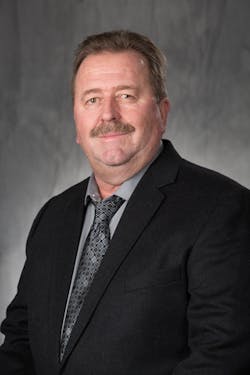In September, Tropical Storm Irma slammed through southern areas of the United States and the Caribbean Islands, causing record flooding, devastating property damage, and a death toll of over 70. Before the month was finished, the Boyd Group announced that all 63 of its collision repair shops (most of which are Gerber Collision & Glass facilities) in Florida and Georgia that were temporarily closed had reopened.
“We are pleased to report that all of our employees have come through this storm safely,” said Tim O’Day, according to a press release on Sept. 27. “We continue to support them and our local communities as they are coming together to rebuild. Our thoughts are with those that have been negatively affected by this and other recent storms.”
Steve Laszlo, Gerber Collision & Glass’ regional vice president from Florida, shares how the company was able to get up and running so quickly—and what lessons they’ve learned from such a disastrous event.
Before Irma, what sort of process did Boyd have in place for disaster relief?
Corporately, we’ve had existing disaster plans in place for many years. These are reviewed annually as part of our planning process and we discuss it regionally, particularly in areas like Florida that are prone to tropical storms and hurricanes. Gerber Collision & Glass recognizes these situations could present hardships for our team members. During a natural disaster like this we understand it can be very challenging for employees to be focused on their work when they are worried about the welfare of their family and the protection of their home and property. A decision was made to support employees and reduce their personal burden by paying team members for the days our shops were closed due to the storm. Thankfully, we did not have any team members who experienced severe injury or property damage during Hurricane Irma.
Once the it was known where the hurricane would hit these areas, what was done?
We’ve had protocols in place for many years. The safety of our team members and their families, our customers and their vehicles has always been at the forefront of our preparation processes. It was crucial that everyone knew what they needed to do to prepare and that our team members understood that if they lived in an evacuation zone how that process worked.
Gerber made sure each of our team members were made aware of shelters in local areas. We communicated to our leaders once a threat of a storm was confirmed. Once the threat was confirmed, we also communicated with our customers daily to assure them we were doing everything we could to ensure the safety of their vehicles. We secured customers’ vehicles inside our shops and we had no damage to any cars during this most recent hurricane.
Each team member is provided an emergency contact number that we utilize during situations like this. We have a chain of command that we follow: Shop employees stay in contact with their managers who ultimately communicate with our executive management team on a daily basis.
Why is having a disaster response plan so important to Gerber?
How we treat our employees and our customers is fundamental to Gerber’s core values and guides our actions in difficult situations like this. Our experience from working in catastrophe insurance and the collision repair industry has prepared Gerber for managing these types of situations. Being proactive with a documented plan in place helped us re-open our shops more quickly and get back to our primary objective of serving our customers after the storm passed.
In a very short amount of time, Gerber was able to get its locations up and running. To what do you owe this success?
The key was properly preparing team members and trying to protect buildings from loose debris during high winds. Since our team members had a detailed plan and knew what to do ahead of time, we quickly executed the steps necessary to protect our shops before the storms hit the area. For example, we secured all potential loose debris that we could and brought our customers’ vehicles inside our facilities. We moved computers and equipment to higher ground in the shops. Without the proper communication with our team members, none of this would have been possible. We provided a daily report to teams within Gerber so everyone was on the same page and aware of our progress.
As soon as it was known that a hurricane was headed to Florida, what happened? Can you take me through the process of before, during and after the storm?
We knew it was a very real possibility that the storm would impact our area. Closing shops before the heart of the storm hit was something we did to give our team members and customers peace of mind. Their safety was, and will always be, our top focus. We proactively closed some shops several days before the storm so that our team members could evacuate. We stayed on top of evacuation notices and made sure everyone had time to secure their homes and property. We also communicated with our corporate office to keep everyone informed about which shops were impacted and when they were closing.
Our Customer Care team worked to update our website and social media platforms so customers were aware of which shops were affected. We secured loose debris around the shops and tried to minimize any damage and we housed customers’ vehicles inside the shops. Moving computers and equipment to higher ground inside the shops is also key.
During the storm, we asked team members to focus on the safety of their families. After the storm passed, we contacted each of our team members to make sure they were safe and tracked the status of their homes. This demonstrates the level of detail of our plan and the importance of having employee contact information on hand and a mechanism to support them through a situation like this. We communicated with customers daily to inform them about any damage to the shops and when we expected to be back open for business. After we assessed each Gerber location, we made the final decision on when we would be able to re-open and shared that information with our team members and on our website.
Since the Tampa area had not been hit by a hurricane of that force in the past 100 years, there was a lot of anxiety and anticipation. We implemented our communication plan to account for everyone’s safety and to inform them about when shops would be closing. After the storm we had team members who worked to restore our shops if any minimal damage occurred. We re-opened as soon as it was safe for our team members and customers.
How are you continuing to support your shops through their relief efforts?
Operations are pretty much back to normal. While we’re still dealing with minimal damage to our locations from the storm, there has been no disruption to our operations since we reopened. All of our shops were back online in a little over a week around the Southwest Florida area. Moving forward, we remain committed to the communities where we do business and will do our part to help the community get back to normal by helping with repair needs due to the storm.
Is there anything that can be done to recover from the lost business days?
While we can’t recover the lost business days, we chose to focus our efforts where we could make a difference: opening our shops as quickly as possible, focusing on the job at hand to complete repairs in a timely fashion, and supporting community efforts to rebuild after the storm. It was a very difficult time, but we are focused on the long term and serving the community. We don’t expect this to have any impact on our future operations.
If a smaller MSO was looking to set-up and emergency disaster relief plan, what advice would you give?
Being properly prepared is a must. Implementing a system of communication with your employees and customers is essential and understanding the impact of government issued evacuations is important. You need to consider all your stakeholders and the impact on them. For example, assuring customers that their vehicles are as safe possible before and after the storm is imperative. We had multiple customers tell us they were relieved to know we had their vehicles taken care of beforehand, as this was one less thing they need to be concerned about during a natural disaster.

